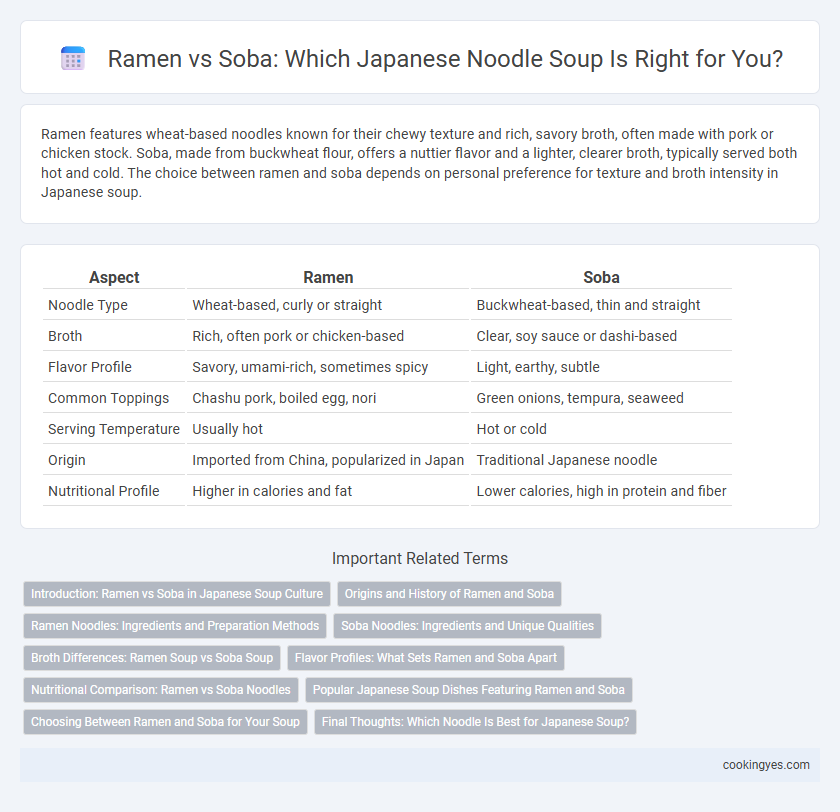Ramen features wheat-based noodles known for their chewy texture and rich, savory broth, often made with pork or chicken stock. Soba, made from buckwheat flour, offers a nuttier flavor and a lighter, clearer broth, typically served both hot and cold. The choice between ramen and soba depends on personal preference for texture and broth intensity in Japanese soup.
Table of Comparison
| Aspect | Ramen | Soba |
|---|---|---|
| Noodle Type | Wheat-based, curly or straight | Buckwheat-based, thin and straight |
| Broth | Rich, often pork or chicken-based | Clear, soy sauce or dashi-based |
| Flavor Profile | Savory, umami-rich, sometimes spicy | Light, earthy, subtle |
| Common Toppings | Chashu pork, boiled egg, nori | Green onions, tempura, seaweed |
| Serving Temperature | Usually hot | Hot or cold |
| Origin | Imported from China, popularized in Japan | Traditional Japanese noodle |
| Nutritional Profile | Higher in calories and fat | Lower calories, high in protein and fiber |
Introduction: Ramen vs Soba in Japanese Soup Culture
Ramen and soba are prominent noodle varieties deeply embedded in Japanese soup culture, each offering distinct textures and flavors. Ramen typically features wheat-based noodles served in rich, savory broths that often include pork, miso, or soy sauce, reflecting regional diversity. Soba, made from buckwheat flour, provides a lighter, nuttier taste and is commonly enjoyed in clear dashi-based soups or chilled dishes, emphasizing its traditional and healthful aspects.
Origins and History of Ramen and Soba
Ramen originated in China and was adapted in Japan during the early 20th century, becoming a staple of Japanese cuisine with regional variations such as tonkotsu and miso ramen. Soba, made from buckwheat flour, has a much older history in Japan dating back to the Edo period, traditionally enjoyed both hot and cold as a symbol of longevity and good fortune. While ramen reflects foreign influence and culinary innovation, soba embodies Japan's agricultural heritage and cultural symbolism.
Ramen Noodles: Ingredients and Preparation Methods
Ramen noodles are typically made from wheat flour, water, salt, and kansui, an alkaline mineral water that gives them their unique chewy texture and yellow color. The preparation involves boiling the noodles until they reach a firm yet tender consistency, which complements the rich and savory broth commonly made from pork, chicken, or miso. Unlike soba noodles, which are made from buckwheat and have a nuttier flavor, ramen noodles are designed to absorb the flavorful soup base, enhancing the overall taste experience in Japanese ramen dishes.
Soba Noodles: Ingredients and Unique Qualities
Soba noodles are traditionally made from buckwheat flour, offering a nutty flavor and a firm but tender texture distinct from wheat-based ramen. Their high buckwheat content provides nutritional benefits, including protein, fiber, and essential minerals like manganese. Soba's unique qualities include its earthy aroma and natural gluten-free properties, making it a versatile choice for both hot soups and cold dishes in Japanese cuisine.
Broth Differences: Ramen Soup vs Soba Soup
Ramen broth is typically rich and hearty, made from pork, chicken, or seafood bones simmered for hours to create a deeply flavorful base often enhanced with soy sauce, miso, or salt. Soba soup broth, called tsuyu, is lighter and clearer, primarily crafted from dashi made with kombu seaweed, katsuobushi (bonito flakes), and soy sauce, offering a delicate umami flavor. The contrasting broth profiles define the distinct taste experiences of ramen's robust richness versus soba's subtle and refreshing clarity.
Flavor Profiles: What Sets Ramen and Soba Apart
Ramen features a rich, savory broth often made from pork, chicken, or miso, delivering bold umami flavors complemented by curly wheat noodles. Soba offers a lighter, earthier taste with its buckwheat noodles and clear dashi-based broth, highlighting subtle sweetness and a clean finish. These distinct flavor profiles make ramen hearty and robust, while soba remains delicate and refreshing in Japanese soup dishes.
Nutritional Comparison: Ramen vs Soba Noodles
Soba noodles, made from buckwheat, offer higher protein content, more fiber, and essential minerals like manganese compared to ramen, which typically contains refined wheat flour and higher sodium levels due to its broth and seasoning. Ramen noodles are often richer in calories and fat, influenced by the oil used in frying and the fatty toppings commonly served with ramen dishes. For a healthier Japanese soup option, soba provides a balanced nutritional profile with lower calories and beneficial antioxidants from buckwheat, supporting cardiovascular health and digestion.
Popular Japanese Soup Dishes Featuring Ramen and Soba
Ramen and soba are two iconic Japanese soups, each with distinct characteristics and ingredients. Ramen features wheat-based noodles served in rich, flavorful broths like miso, shoyu, or tonkotsu, often topped with chashu pork, soft-boiled eggs, and green onions. Soba, made from buckwheat noodles, is typically enjoyed either cold with dipping sauce or in hot broth, highlighting a lighter, earthier taste often accompanied by tempura or scallions.
Choosing Between Ramen and Soba for Your Soup
Ramen features wheat-based noodles with a rich, often pork or miso broth, providing a hearty and savory flavor profile ideal for those seeking a filling meal. Soba, made from buckwheat, offers a lighter, earthier taste and is frequently served in a clear dashi broth, appealing to diners preferring a health-conscious and subtle option. When choosing between ramen and soba for your Japanese soup, consider the noodle texture, broth intensity, and nutritional preferences to match your desired dining experience.
Final Thoughts: Which Noodle Is Best for Japanese Soup?
Ramen noodles offer a rich, chewy texture ideal for hearty, flavorful broths like tonkotsu or miso, enhancing the overall soup experience. Soba noodles provide a light, nutty flavor and firmer bite, perfect for clear, delicate broths such as dashi-based soups. Choosing between ramen and soba depends on the desired broth intensity and texture preference, with ramen suiting bold flavors and soba complementing subtle, refined tastes.
Ramen vs soba for Japanese soup Infographic

 cookingyes.com
cookingyes.com